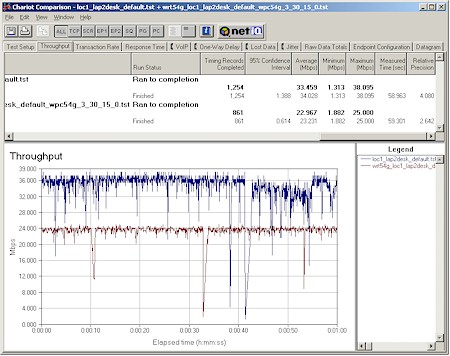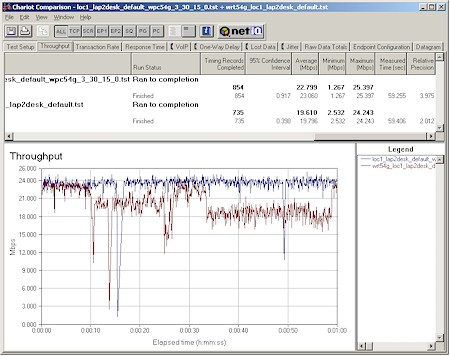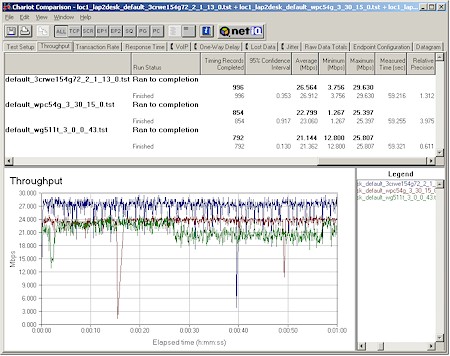Digging into Afterburner
With the basics out of the way, let's now take a closer look at Afterburner. The three questions that I'm sure are on your mind (at least they're on mine) are:
- Does SpeedBooster / Afterburner really work (i.e, provide up to 35% speed improvement)?
- How does it work with non Speed-Boosted clients?
- Which is better, Afterburner or Super-G?
In order to answer these questions as fairly as possible, I decided to compare the combination of WRT54GS and WPC54GS CardBus client with a WRT54G / WPC54G reference pair, i.e. Linksys' previous generation equivalent products. Before testing, I upgraded the WRT54G to the latest 2.02.7 firmware and the WPC54G to the latest 3.30.15.0 XP driver freshly downloaded from Linksys' website. All testing was done on Channel 6 with no encryption enabled.
To be consistent with my previous tests of Atheros' Super-G based products in the Atheros Super-G NeedToKnow - Parts 1 and 2, I used the same pair of computers running WinXP. The test results looked a little low, however, so on a hunch, I swapped in a 2.4GHz Pentium 4 WinXP machine for my older 266MHz Celeron laptop. The new results looked much better, which has caused me to revise my rule of thumb for using "enhanced" 802.11g products, i.e.
Don't expect to see the full benefit of "enhanced" 802.11g products unless both ends of the connection are running WinXP on at least 1GHz machines.
I suspect - though haven't tested - that you could substitute Win2000 and probably other OSes in the above rule, and might even be able to lower the processor requirements if you're running Linux or other Open Source OS variant. But if you're still running Win98 (or earlier) and want to get the most from your investment in 802.11g products, you should upgrade to either WinXP or an Open Source OS.
With that out of the way, Figure 10 should provide the answer to the first question.

Figure 10: SpeedBoost vs. Previous Generation
(click on the image for a full-sized view)
The plot shows test runs made with each router / client pair about 6 feet apart. Each run had only one router / client pair operating at a time and no other 802.11b or g products in range. The only change I made from router default settings is that on the WRT54G I changed the CTS Protection mode from its default of Disable to Auto and the Frame Burst setting from its default of Disable to Enable. The upper trace shows the SpeedBoosted pair throughput while the bottom is what I got from the WRT54G / WPC54G pair.
The results show a 46.5% (34.0 / 23.2 Mbps) average throughput gain from the SpeedBoosted products, well above Linksys' promised 35%! Comparisons of maximum and eyeball-averaged speeds yield similar results.
With the first question out of the way, let's move to seeing how well Afterburner plays with non-Afterburner clients. I performed two more test runs, this time swapping clients between routers to check forward and backward compatibility of the SpeedBooster technology.

Figure 11: Cross-client test
(click on the image for a full-sized view)
Figure 11 shows that in both cases (the bluish trace is WRT54GS / WPC54G, the reddish is WRT54G / WPC54GS), throughput drops to about 24 Mbps, which from Figure 10 looks like the best case for non-Afterburner performance. This plot also shows that the WPC54GS' (client card) driver probably has some tuning left to do, since the larger throughput variation seems to follow it.
I also checked to see whether Afterburner had any detrimental effects on non-Afterburner clients.

Figure 12: Non Afterburner client comparison
(click on the image for a full-sized view)
Figure 12 shows close range runs using the WRT54GS as the router and with the following clients:
- Linksys WPC54G - Broadcom non-Afterburner chipset [3.30.15.0 XP driver]
- NETGEAR WG511T - Atheros Super-G chipset [3.0.0.43 XP driver (unreleased)]
- 3Com 3CRWE154G72 - PRISM GT chipset [2.1.13.0 XP driver]
I was surprised to find that, with an average throughput of about 27 Mbps, the PRISM GT chipset actually did better than Broadcom's previous generation chipset when used with the Afterburner-equipped WRT54GS! Although the Atheros-based NETGEAR WG511T's average throughput number came in almost 10% lower than the Broadcom chipset, the plot shows this is primarily due to higher throughput variation.